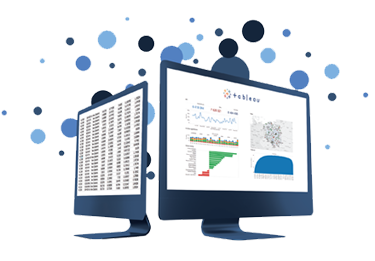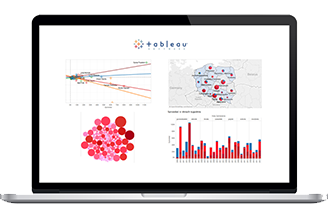Tableau
Tableau users continue to grow. The easy-to-use and functional BI tool is already used by more than 90,000 businesses, and the number is growing. Well-known corporations such as Facebook or Walmart visualize their data precisely with Tableau.What is one of the best Business Intelligence tools according to Gartner Group report?
Try it for free
Tableau – what is it?

Tableau is a tool for visual, Data Discovery-based data analytics.
The BI tool instantly integrates with any data source and enables data analysis not only for specialists, but anyone who wants to create clear visualizations based on their data.
It has over 80 built-in connections for various data sources, including ORACLE, ERP systems (SAP, AX, CDN, IMPULS), MS SQL SERVER, MySQL, DB2, Google Analytics, Hadoop, R, SAP HANA or MS EXCEL.
It has over 80 built-in connections for various data sources, including ORACLE, ERP systems (SAP, AX, CDN, IMPULS), MS SQL SERVER, MySQL, DB2, Google Analytics, Hadoop, R, SAP HANA or MS EXCEL.
Tableau is a way to make better use of your data. The tool provides rich possibilities for data analysis, visualization and presentation.
Use Tableau to analyze and access data several hundred times faster than with traditional tools. Make data-driven business decisions to save time and money.
Use Tableau to analyze and access data several hundred times faster than with traditional tools. Make data-driven business decisions to save time and money.
By integrating with the data source in LIVE mode, you can immediately see the changes occurring in the source data, but the performance of the database is then a limitation. \
In EXTRACT mode, on the other hand, you have the ability to analyze hundreds of millions of records without a long wait. Tableau works within the company’s data architecture and access security.
In EXTRACT mode, on the other hand, you have the ability to analyze hundreds of millions of records without a long wait. Tableau works within the company’s data architecture and access security.
Find out more >
Tableau – why is it worth implementing?

What are the benefits of implementing Tableau? The tool allows for instant data analysis and enables processing of hundreds of millions of records in an extremely short time. Working with Tableau is faster, more efficient and more productive. It only takes a few moments to create analytics and dashboards and share them. With clear visualizations, Tableau helps you make sense of your data and helps you make the right business decisions.
You can use the tool not only on your computer, but also on mobile devices, which makes it easier to access the analysis results. Tableau provides unlimited possibilities for data analysis. You can combine data from different sources in a single extract. You can also present data on point or area maps. The tool is available to anyone and its operation does not require IT knowledge.
Find out more >
You can use the tool not only on your computer, but also on mobile devices, which makes it easier to access the analysis results. Tableau provides unlimited possibilities for data analysis. You can combine data from different sources in a single extract. You can also present data on point or area maps. The tool is available to anyone and its operation does not require IT knowledge.
Find out more >
Tableau – products

Tableau Desktop
One of Tableau’s products is Tableau Desktop, which allows you to connect to and analyze data in a few clicks. Use Tableau Desktop to create visualizations and dashboards without programming. Share analysis results easily and quickly. The in-memory database engine speeds up analysis, and the user gains the ability to filter and drill down into the data. The result is an interactive, clear visualization that lets you understand your data.
See more >

Tableau Server
Tableau solutions also include Tableau Server, which enables analytics not only in the browser but also on mobile devices. It provides permission management and security for data that is published on Tableau server in the form of interactive dashboards. Once they are published, the user can filter, highlight, and analyze server content. By integrating the tool with the company’s database architecture, its security protocols are taken into account and the security requirements of even the largest organizations are met.
See more >

Tableau Reader
This is a desktop, workstation-installed tool. Use them to work interactively with reports in the form of files saved in TWBX format. Use any filter criteria you like. The limitations of this solution include the inability to read on mobile devices, drill down data to the source document level, lack of user permissions and automatic data refresh.
See more >

Tableau Online
Tableau Online is a cloud-based web platform. Use it to share views, dashboards and data sources without IT support and local server involvement. Publish dashboards, filter and drill down data, edit reports on the site and save changes. Receive subscriptions and refresh data. The platform is hosted by Tableau, and only authenticated users can access the data.
See more >

Tableau Public
Use the free Tableau Public server to publish interactive data on the web. Instantly create visualizations, publish data and share on social media or via email. Anyone can use the published data, download it or create new visualizations based on it.
Tableau Price List >

Tableau Prep
This tool is used to prepare data for analysis in Tableau. Use Tableau Prep to clean up your data and create arbitrarily complex data sources. Tableau Prep will help you check the quality of your data and understand its structure. You can test Tableau products for free. NewDataLabS is offering free 14-day access for you to explore their functionality. Take this opportunity to visualize your data to ensure the success of your business.
See more >
Tableau – history
It all started with a study commissioned by the U.S. Department of Defense to increase the ability to analyze information in a short period of time. The task was undertaken by Chris Stolte and Pat Hanrahan of Stanford University in San Francisco. They concluded that the key was to combine database technology and computer graphics capabilities in a single tool. This is how the VizQL technology was created.
It allowed people to analyze data using simple, graphical drag & drop tools. When Christian Chabot, a data analysis specialist saw the results of Pat and Chris’ work he said: “I see the future.” This was the start of Tableau, and Christian Chabot took over as CEO of Tableau Software, which quickly became successful. The tool brought a revolution in working with data in business, and Tableau Software became the world’s leading provider of modern tools that support data analysis and visualization.
It allowed people to analyze data using simple, graphical drag & drop tools. When Christian Chabot, a data analysis specialist saw the results of Pat and Chris’ work he said: “I see the future.” This was the start of Tableau, and Christian Chabot took over as CEO of Tableau Software, which quickly became successful. The tool brought a revolution in working with data in business, and Tableau Software became the world’s leading provider of modern tools that support data analysis and visualization.





